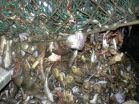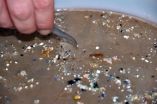(Press-News.org) New research on HIV transmission shows that viral fitness is an important basis of a "genetic bottleneck" imposed every time a new person is infected. The findings define a window of opportunity for drugs or vaccines to prevent or limit infection.
HIV represents evolution on overdrive. Every infected individual contains a swarm of viruses that exhibit variability in their RNA sequence, and new mutations are constantly appearing. Yet nearly every time someone new is infected, this diverse population of viruses gets squeezed down to just one individual.
The genetic bottleneck effect was known, but now the selection for viral fitness driving it is becoming clear. Researchers have found that viral protein sequences matching a consensus sequence, which is hypothesized to be most fit, are more likely to be transmitted than those that deviate from the consensus.
The results are scheduled for publication this week in Science.
"The best explanation for what we are seeing is that frequently, after exposure to HIV, a few cells in the genital tract are infected, without establishment of a systemic infection," says senior investigator Eric Hunter, PhD, professor of pathology and laboratory medicine at Emory University School of Medicine, Emory Vaccine Center, and Yerkes National Primate Research Center. Hunter is a Georgia Research Alliance Eminent Scholar.
"We now have evidence that the game isn't lost as soon as the first target cell is infected. It suggests that any approach that makes it more difficult for the virus to replicate in a cell, or that targets infected cells for killing before they can release new viruses, will reduce the probability of systemic infection."
Scientists led by Hunter at Emory Vaccine Center/Center for AIDS Research teamed up with lead author Jonathan Carlson, PhD, and colleagues at Microsoft Research. The team collaborated with Susan Allen at Emory, and her HIV prevention programs in Zambia that enroll heterosexual couples with one HIV-positive partner. These programs provide counseling and condoms, but HIV transmission still occurs despite a two-thirds reduction in the infection rate.
Regular blood tests and close monitoring allowed the researchers to compare the virus that gets transmitted to the viruses in the chronically infected partner, for 137 transmission events over 10 years. Further monitoring in the first two years of infection permitted the team to track the effects of viral mutations.
"We hypothesized that individual mutations in viral genes could be expected to have a range of effects on the virus's ability to replicate, to infect new cells and escape the immune system," Carlson says. "What we found was that even minor changes away from the consensus HIV-1 sequence had a measurable effect on the likelihood of transmission."
This selection bias was reduced in couples where there was a higher risk of transmission. In particular, the fitness bottleneck was less severe in male-to-female transmission than in female-to-male. It was also less severe in female-to-male transmission when the male partner had genital inflammation.
"The observation that women are often infected with more mutated viruses than men shows that the transmission barrier is higher when infecting men and lower for women," Hunter says. "This highlights an important paradox: although men are less likely to be infected, when they are infected, it's typically by fitter viruses that initially, at least, cause a more severe disease."
"Moreover, a key finding of this study is that individuals infected with more mutated, 'weaker', viral populations are less likely to transmit to their partner," Carlson says. "Thus, if an HIV vaccine, antiretroviral therapy, or natural immune escape leads to weaker circulation viruses throughout the human population, the overall rate of transmission would likely be reduced."
INFORMATION: END
Window of opportunity against HIV comes from 'fitness bottleneck'
Viral fitness tracks with likelihood of transmission
2014-07-10
ELSE PRESS RELEASES FROM THIS DATE:
Study points to potential new target for antibiotics against E. coli, other bugs
2014-07-10
COLUMBUS, Ohio – Scientists have identified a protein that is essential to the survival of E. coli bacteria, and consider the protein a potential new target for antibiotics.
In the study, the researchers confirmed that this protein, called MurJ, flips a fatty molecule from one side of a bacterial cell membrane to the other. If that molecule isn't flipped, the cell cannot construct a critical layer that keeps pressurized contents of the cell contained. If those contents aren't contained, the cell bursts.
E. coli is part of the gram-negative family of bacteria, characterized ...
Cultured CTCs reveal genetic profile, potential drug susceptibility of breast cancer cells
2014-07-10
Circulating tumor cells captured with a microchip-based device developed at the Massachusetts General Hospital (MGH) Center for Engineering in Medicine and the MGH Cancer Center can be cultured to establish cell lines for genetic analysis and drug testing. In the July 11 issue of Science, an MGH research team reports that the cultured cells accurately reflect a tumor's genetic mutation over time and changing susceptibility to therapeutic drugs.
"We now can culture cells from the blood that represent those present in metastatic deposits, which allows testing for drug ...
Inherited 'memory' of environmental impact on health may be limited
2014-07-10
When a pregnant mother is undernourished, her child is at a greater than average risk of developing obesity and type 2 diabetes, in part due to so-called 'epigenetic' effects. A new study in mice demonstrates that this 'memory' of nutrition during pregnancy can be passed through sperm of male offspring to the next generation, increasing risk of disease for her grandchildren as well. In other words, to adapt an old maxim, 'you are what your grandmother ate'. The study also raises questions over how epigenetic effects are passed down from one generation to the next – and ...
Researchers harness a powerful new source of up-to-date information on economic activity
2014-07-10
ANN ARBOR--- Researchers at the University of Michigan, University of California Berkeley, and Arizona State University have developed a new data infrastructure for measuring economic activity.
The infrastructure uses aggregated and de-identified data on transactions and account balances from Check, a mobile payments app, to produce accurate and comprehensive measures of consumers' spending and income on a daily basis.
In a paper appearing in the July 11 issue of Science, economists Michael Gelman, Shachar Kariv, Matthew Shapiro, Dan Silverman, and Steven Tadelis ...
International science team solve biological mystery
2014-07-10
This news release is available in German.
An international team of researchers, led by the University of Leicester, has solved a long-standing mystery in biology, by identifying the molecular structure of a vital biological chemical. The debate – which has raged within the scientific community for years – boils down to something as simple as a hydrogen atom: is it there, or is it not?
The controversy centres around a form of enzyme called a heme (or haem, as in haemoglobin) at the centre of which is an iron atom (Fe) called a 'ferryl' which becomes oxidised when ...
Overfishing in the English Channel leaves fisherman scraping the bottom of the barrel
2014-07-10
Decades of overfishing in the English Channel has resulted in the removal of many top predators from the sea and left fishermen 'scraping the barrel' for increasing amounts of shellfish to make up their catch.
Sharks, rays, cod, haddock and many other species at the head of the food chain are at historic lows with many removed from the area completely.
These are some of the findings of a study led by marine biologists at Plymouth University, in association with international non-profit research organization WorldFish. They analysed catches over the past 90 years and found ...
Uncertainty gives scientists new confidence in search for novel materials
2014-07-10
Scientists at Stanford University and the Department of Energy's SLAC National Accelerator Laboratory have found a way to estimate uncertainties in computer calculations that are widely used to speed the search for new materials for industry, electronics, energy, drug design and a host of other applications. The technique, reported in the July 11 issue of Science, should quickly be adopted in studies that produce some 30,000 scientific papers per year.
"Over the past 10 years our ability to calculate the properties of materials and chemicals, such as reactivity and mechanical ...
Scripps scientists discover evidence of super-fast deep earthquake
2014-07-10
As scientists learn more about earthquakes that rupture at fault zones near the planet's surface—and the mechanisms that trigger them—an even more intriguing earthquake mystery lies deeper in the planet.
Scientists at Scripps Institution of Oceanography at UC San Diego have discovered the first evidence that deep earthquakes, those breaking at more than 400 kilometers (250 miles) below Earth's surface, can rupture much faster than ordinary earthquakes. The finding gives seismologists new clues about the forces behind deep earthquakes as well as fast-breaking earthquakes ...
Leading scientists express rising concern about 'microplastics' in the ocean
2014-07-10
Microplastics – microscopic particles of plastic debris – are of increasing concern because of their widespread presence in the oceans and the potential physical and toxicological risks they pose to organisms.
This is the view of two of the world's most eminent authorities on the subject, Professor Kara Lavender Law, of Sea Education Association (Woods Hole, MA), and Professor Richard Thompson of Plymouth University (UK).
In an article published today in the journal Science, the two scientists have called for urgent action to "turn off the tap" and divert plastic waste ...
Control strategy for Dengue, malaria increases risk of West Nile virus
2014-07-10
Mosquitoes infected with the bacteria Wolbachia are more likely to become infected with West Nile virus and more likely to transmit the virus to humans, according to a team of researchers.
"Previous research has shown that Wolbachia -- a genus of bacteria that live inside mosquitoes -- render mosquitoes resistant to pathogen infection, thereby preventing the mosquitoes from infecting humans with the pathogens," said Jason Rasgon, associate professor of entomology, Penn State. "As a result, researchers are currently releasing Wolbachia-infected mosquitoes into the wild ...
LAST 30 PRESS RELEASES:
Ribosomal engineering creates “super-probiotic” bacteria
This self-powered eye tracker harnesses energy from blinking and is as comfortable as everyday glasses
Adverse prenatal exposures linked to higher rates of mental health issues, brain changes in adolescents
Restoring mitochondria shows promise for treating chronic nerve pain
Nature study identifies a molecular switch that controls transitions between single-celled and multicellular forms
USU chemists' CRISPR discovery could lead to single diagnostic test for COVID, flu, RSV
Early hominins from Morocco reveal an African lineage near the root of Homo sapiens
Small chimps, big risks: What chimps show us about our own behavior
We finally know how the most common types of planets are created
Thirty-year risk of cardiovascular disease among healthy women according to clinical thresholds of lipoprotein(a)
Yoga for opioid withdrawal and autonomic regulation
Gene therapy ‘switch’ may offer non-addictive pain relief
Study shows your genes determine how fast your DNA mutates with age
Common brain parasite can infect your immune cells. Here's why that's probably OK
International experts connect infections and aging through cellular senescence
An AI–DFT integrated framework accelerates materials discovery and design
Twist to reshape, shift to transform: Bilayer structure enables multifunctional imaging
CUNY Graduate Center and its academic partners awarded more than $1M by Google.org to advance statewide AI education through the Empire AI consortium
Mount Sinai Health system receives $8.5 million NIH grant renewal to advance research on long-term outcomes in children with congenital heart disease
Researchers develop treatment for advanced prostate cancer that could eliminate severe side effects
Keck Medicine of USC names Christian Pass chief financial officer
Inflatable fabric robotic arm picks apples
MD Anderson and SOPHiA GENETICS announce strategic collaboration to accelerate AI-driven precision oncology
Oil residues can travel over 5,000 miles on ocean debris, study finds
Korea University researchers discover that cholesterol-lowering drug can overcome chemotherapy resistance in triple-negative breast cancer
Ushikuvirus: A newly discovered giant virus may offer clues to the origin of life
Boosting the cell’s own cleanup
Movement matters: Light activity led to better survival in diabetes, heart, kidney disease
Method developed to identify best treatment combinations for glioblastoma based on unique cellular targets
Self-guided behavioral app helps children with epilepsy sleep earlier
[Press-News.org] Window of opportunity against HIV comes from 'fitness bottleneck'Viral fitness tracks with likelihood of transmission


